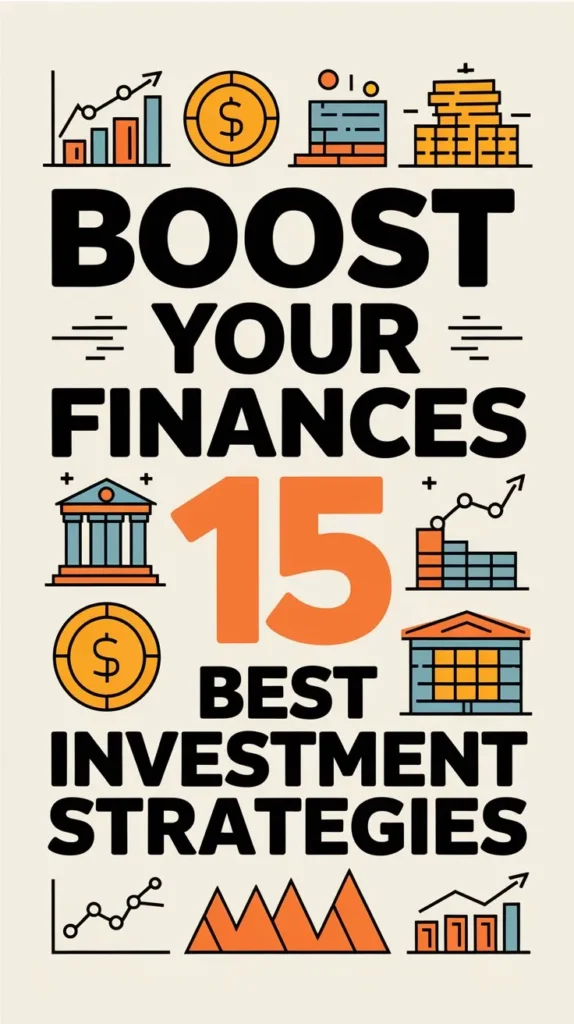As you consider your investment strategy for 2024, you’re likely looking for ways to diversify your portfolio and maximize returns. With so many options available, it can be overwhelming to decide where to start.
You might be wondering whether high-yield savings accounts or index funds are the way to go, or if you should take a chance on emerging market funds or real estate crowdfunding. Whatever your financial goals and risk tolerance, there’s an investment option that’s right for you. But which ones will offer the best returns in 2024, and how can you make the most of them?
In A Nutshell
- High-yield savings accounts offer a low-risk investment option with relatively stable returns and compounding benefits.
- Index funds and ETFs track a specific market index, providing broad diversification and potential long-term growth.
- REITs provide a unique opportunity for real estate investment without direct property management, offering regular income and diversification.
- Alternative investments like gold and precious metals provide a hedge against inflation and market volatility, reducing portfolio risk.
- Dividend-paying stocks generate regular income and potentially lower volatility, with a focus on sustainability and strong cash flow generation.
High-Yield Savings Accounts

When it comes to investing, you’re likely looking for options that balance risk and return.
High-yield savings accounts are a popular choice for those seeking a low-risk investment option with relatively stable returns. These accounts offer higher interest rates compared to traditional savings accounts, making them an attractive option for investors who want to earn more from their money.
One of the key benefits of high-yield savings accounts is the compounding benefits. With compounding, interest is applied to both the principal amount and any accrued interest, resulting in exponential growth over time.
This can lead to significant returns, especially for long-term investments. Interest rates for high-yield savings accounts can vary, but they’re often higher than those offered by traditional savings accounts. Some high-yield savings accounts also offer tiered interest rates, where higher balances earn higher rates.
Index Funds and ETFs
If you’re looking for a more dynamic investment option that still balances risk and return, consider index funds and ETFs.
These investments track a specific market index, such as the S&P 500, to provide broad diversification and potential long-term growth. Index funds and ETFs are designed to replicate the performance of their underlying index, allowing you to own a small piece of the overall market.
By investing in index funds and ETFs, you can achieve index diversification, which can help reduce risk and increase potential returns.
When selecting an ETF, consider the following factors:
- Underlying index: Choose an ETF that tracks a reputable index, such as the S&P 500 or the Dow Jones Industrial Average.
- Fees and expenses: Look for ETFs with low fees and expenses to minimize the impact on your returns.
- Trading volume: Select an ETF with high trading volume to guarantee liquidity and minimize trading costs.
- Tracking error: Opt for an ETF with a low tracking error to minimize the difference between the ETF’s performance and the underlying index.
Dividend-Paying Stocks
Many investors turn to dividend-paying stocks as a way to generate regular income and potentially lower volatility in their portfolios.
You can benefit from investing in these stocks by adding a steady stream of income to your investment portfolio.
To find the best dividend-paying stocks, you’ll want to use a stock screening process to identify companies with a history of paying consistent dividends.
When evaluating dividend-paying stocks, you’ll want to weigh dividend sustainability.
This means looking at the company’s ability to continue paying dividends in the future.
You can assess dividend sustainability by analyzing the company’s cash flow, debt levels, and overall financial health.
A company with a strong balance sheet and a history of generating consistent cash flow is more likely to maintain its dividend payments.
Real Estate Investment Trusts
As you expand your investment portfolio to include more income-generating assets, consider exploring Real Estate Investment Trusts (REITs) as an alternative to traditional dividend-paying stocks.
REITs allow you to invest in real estate without directly managing properties, providing a unique opportunity for diversification. By investing in REITs, you can gain exposure to various property types, such as office buildings, apartments, and shopping centers.
- Diversification: REITs can help you spread risk across different asset classes and property types, reducing your reliance on individual stocks or bonds.
- Professional property management: REITs are managed by experienced professionals who handle property acquisition, maintenance, and leasing, freeing you from direct management responsibilities.
- Regular income: REITs are required to distribute at least 90% of their taxable income to shareholders, providing a regular stream of income.
- Liquidity: REITs are traded on major stock exchanges, making it easy to buy and sell shares as needed.
Gold and Precious Metals
Investing in gold and precious metals offers you a tangible alternative to traditional stocks and bonds, providing a unique hedge against inflation, currency fluctuations, and market volatility.
When you’re looking to diversify your portfolio, adding gold or other precious metals like silver, platinum, or palladium can be a strategic move. These metals have historically performed well during economic downturns, making them a popular choice for investors seeking to reduce risk.
As you build your precious portfolios, it’s crucial to ponder how you’ll store your physical gold or other metals.
Gold storage options include home safes, bank safety deposit boxes, or third-party storage facilities. Each option has its pros and cons, and you’ll want to choose the one that best fits your needs and budget.
You may also want to explore alternative ways to invest in precious metals, such as through exchange-traded funds (ETFs) or mutual funds that track the price of gold or other metals.
Cryptocurrency Trading
Diving head-first into cryptocurrency trading requires you to navigate a complex web of digital assets, risks, and potential rewards.
As you consider this investment option, crucially, you must comprehend the tools and strategies that can help you succeed.
To get started, you’ll need a secure way to store your digital assets.
This is where crypto wallets come in – they provide a safe and convenient way to manage your cryptocurrencies.
Another key tool is trading bots, which can help you automate your investment decisions and react quickly to market changes.
- Understand the fees: Trading fees can eat into your profits, so vitally, you must comprehend the fees associated with your trading platform and crypto wallet.
- Diversify your portfolio: Spread your investments across a range of cryptocurrencies to minimize risk.
- Stay informed: Keep up-to-date with market news and trends to make informed investment decisions.
- Set clear goals: Define your investment goals and risk tolerance to help guide your trading decisions.
Peer-to-Peer Lending
Peer-to-peer lending offers you a unique opportunity to lend money directly to individuals or small businesses, bypassing traditional financial institutions.
By using online lending platforms, you can diversify your investment portfolio and potentially earn higher returns. These platforms act as intermediaries between you and the borrowers, handling tasks such as loan origination, credit checks, and repayment collection.
Before investing in peer-to-peer lending, it is vital to understand the risks involved. A thorough risk assessment is pivotal to minimize potential losses.
Lending platforms typically offer various risk grades or categories, which help you evaluate the creditworthiness of borrowers. You can choose to lend to lower-risk borrowers with lower returns or take on more risk for potentially higher returns.
To get started, research and compare different lending platforms, considering factors such as fees, interest rates, and default rates. Look for platforms that offer transparent and robust risk assessment processes, as well as a track record of successful loan repayments.
Robo-Advisors and AI
Many investors are turning to robo-advisors and AI-powered investment platforms to manage their portfolios.
These platforms use algorithms to create and manage AI portfolios, providing you with a low-cost and efficient way to invest.
With automated investing, you can diversify your portfolio and minimize risk.
- Low costs: Robo-advisors and AI-powered investment platforms often have lower fees compared to traditional financial advisors.
- Diversification: These platforms can help you diversify your portfolio by investing in a variety of assets, such as stocks, bonds, and ETFs.
- Tax efficiency: AI-powered investment platforms can help you optimize your portfolio for tax efficiency, reducing your tax liability.
- Convenience: With automated investing, you can manage your portfolio online or through a mobile app, making it easy to invest on the go.
Tax-Advantaged Retirement
A tax-advantaged retirement account can be a powerful tool in your investment arsenal, helping you save for the future while minimizing your tax liability.
By utilizing these accounts, you can make the most of your retirement savings and achieve your long-term goals.
When it comes to tax-advantaged retirement accounts, you have several options to choose from.
Traditional IRAs and 401(k)s allow you to deduct your contributions from your taxable income, reducing your tax liability for the year.
On the other hand, Roth IRAs require you to pay taxes upfront, but the funds grow tax-free and you won’t have to pay taxes when you withdraw them in retirement.
Consider your retirement goals and financial situation when deciding which type of account is best for you.
If you expect to be in a higher tax bracket in retirement, a Roth IRA might be the way to go.
However, if you need the tax deduction now, a traditional IRA or 401(k) could be a better fit.
Small Business Investing
Investing in small businesses can be a lucrative way to diversify your portfolio and potentially earn higher returns on investment.
By supporting local entrepreneurs, you’re not only contributing to the growth of your community but also gaining a stake in innovative ventures. Small business investing can take various forms, including providing capital through small business loans or participating in entrepreneurial finance initiatives.
When considering small business investing, crucially, you must weigh the risks and rewards.
- Diversification: Spread your investments across multiple small businesses to minimize risk and maximize potential returns.
- Research: Conduct thorough research on the business, its management team, and the market demand for its products or services.
- Support systems: Look for businesses with strong support systems, such as mentorship programs or access to resources and networks.
- Exit strategies: Consider the potential exit strategies for your investment, such as selling your stake or receiving regular dividends.
International Stocks
You’ve explored opportunities in small business investing, but it’s also worth pondering the vast array of investment options available globally.
Investing in international stocks can be a great way to diversify your portfolio and tap into the growth potential of foreign markets. By investing in international stocks, you can gain exposure to companies and industries that may not be available in your home market.
Global diversification can help you spread risk and increase potential returns.
It allows you to invest in companies that are leaders in their respective industries, regardless of where they’re based. For example, you could invest in a Japanese tech company, a European luxury goods manufacturer, or a Brazilian mining company.
When investing in international stocks, it’s crucial to weigh factors such as currency fluctuations, regulatory differences, and market volatility.
You can invest directly in foreign markets or through exchange-traded funds (ETFs) or mutual funds that track international indices. By doing your research and taking a thoughtful approach, you can make informed investment decisions and potentially benefit from the growth of foreign markets.
Corporate Bond Investing
Risk management is a key consideration when building a diversified investment portfolio, and corporate bond investing can play a strategic role in this process.
By investing in corporate bonds, you can add a layer of stability to your portfolio while generating regular income. However, it is vital to understand the risks involved and take steps to safeguard them.
When investing in corporate bonds, you’ll want to deliberate the following:
- Credit ratings: Look for bonds with high credit ratings, as they indicate a lower risk of default.
- Bond ladders: Create a bond ladder by investing in bonds with staggered maturity dates to reduce interest rate risk.
- Diversification: Spread your investments across various industries and companies to minimize exposure to any one particular sector.
- Yield analysis: Carefully evaluate the yield of each bond to verify it aligns with your investment goals and risk tolerance.
Real Estate Crowdfunding
Real estate crowdfunding has emerged as a popular alternative for individuals looking to diversify their portfolios beyond traditional stocks and bonds.
You can now invest in real estate without directly managing properties, thanks to platforms that connect investors with Real Estate Flippers and Property Managers. These platforms allow you to pool your funds with other investors to finance projects, providing access to a broader range of investment opportunities.
When investing in real estate crowdfunding, you’ll typically have two options: debt or equity investments.
Debt investments involve lending money to a project developer, who repays the loan with interest. Equity investments, on the other hand, give you a stake in the project’s profits.
You’ll need to assess the project’s potential for returns, the experience of the Property Managers, and the risks involved.
Alternative Energy Stocks
One of the most promising sectors in the market today is alternative energy, with many investors turning to alternative energy stocks as a way to diversify their portfolios and capitalize on the growing demand for renewable energy sources.
As you consider investing in alternative energy stocks, you’ll want to focus on companies that are leading the way in clean energy and renewable power.
- Solar Energy: Companies that specialize in solar panel manufacturing and installation are well-positioned for growth as the demand for renewable energy continues to rise.
- Wind Energy: Wind energy companies are also poised for growth, particularly those that are developing innovative technologies to improve efficiency and reduce costs.
- Hydrokinetic Energy: Hydrokinetic energy companies are harnessing the power of moving water to generate electricity, offering a promising new source of renewable energy.
- Geothermal Energy: Geothermal energy companies are tapping into the heat of the Earth to generate electricity, providing a reliable and constant source of renewable power.
Emerging Market Funds
Investing in emerging markets can be a lucrative way to diversify your portfolio, as these countries are poised for rapid economic growth and industrialization.
Emerging market funds offer you a chance to tap into these emerging opportunities, allowing you to benefit from the growth of countries like China, India, and Brazil. By investing in these funds, you’ll be able to diversify your portfolio and potentially increase your returns.
When considering emerging market funds, vital is to keep an eye on market trends.
Look for funds that focus on countries with strong economic growth prospects, a stable political environment, and a growing middle class.
You should also consider the fund’s investment strategy, fees, and risk level to verify it aligns with your investment goals.
Emerging market funds can be volatile, so paramount is to have a long-term perspective and a well-diversified portfolio.
However, for investors who are willing to take on some risk, emerging market funds can provide a compelling way to tap into the growth potential of these emerging economies.
Frequently Asked Questions
How Do I Minimize Investment Risk in a Volatile Market?
To minimize investment risk in a volatile market, you’re taking the right step by evaluating your risk tolerance and exploring diversification strategies that spread investments across asset classes, reducing reliance on a single market.
Can I Invest With a Small Amount of Capital?
You can start investing with a small amount of capital through micro investing, which allows you to invest small sums regularly. Consider starter funds with low or no minimum balance requirements to get started.
What Fees Should I Expect When Investing in the Stock Market?
When investing in the stock market, you’ll encounter fees like brokerage commissions for buying/selling stocks and management expenses for fund maintenance. These costs vary by brokerage firm and investment type, so research and compare rates.
How Often Should I Review and Adjust My Investment Portfolio?
You should review your investment portfolio quarterly, rebalancing as needed to stay on track with your investment milestones, and annually to assess progress and make strategic adjustments to optimize your returns.
Can I Invest in the Stock Market Without a Financial Advisor?
You can invest in the stock market without a financial advisor by using online platforms that allow self-trading, giving you control over your investments and often lower fees.
FInal Verdict
You’ve explored the top 15 investment options for 2024, each offering unique benefits and risks. By diversifying your portfolio with high-yield savings accounts, index funds, dividend-paying stocks, and more, you’ll spread risk and increase potential gains.
Consider your financial goals and risk tolerance when selecting investments. A well-diversified portfolio can help you achieve long-term success in today’s dynamic market. Analyze each option carefully to make informed investment decisions.






Last update on 2025-03-14 / Affiliate links / Images from Amazon Product Advertising API. Some of the links on this website are affiliate links, which means that at no additional cost to you, I earn a commission if you click through and make a purchase. I only recommend products and services that I believe will add value to my readers. Thank you for your support!







